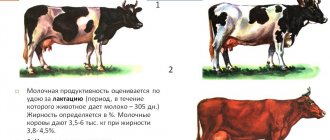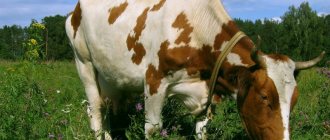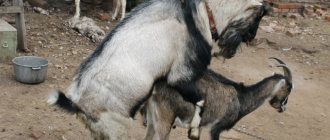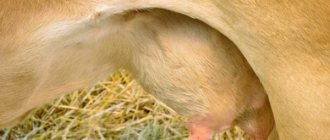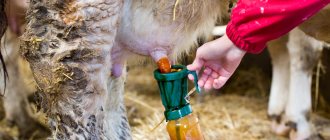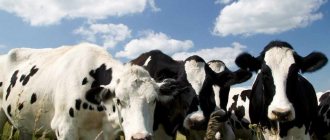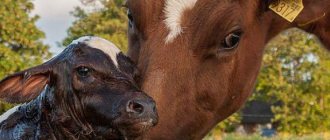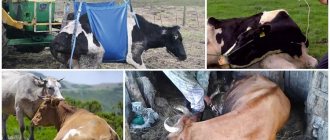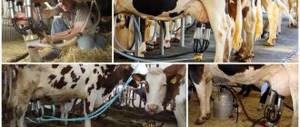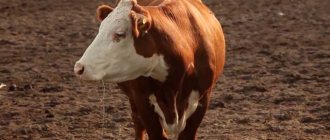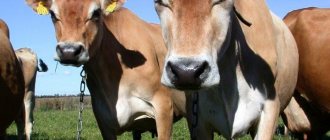Viso-cervical
The set of basic instruments consists of a mirror with an illuminator and a catheter syringe.
Working solutions:
- sterile 1% sodium bicarbonate;
- 2.8 percent sodium citrate;
- 70% alcohol.
Sequence of operations:
- preparation of disinfectant solutions in the laboratory;
- syringe disinfection;
- filling the catheter with sperm;
- moistening the speculum with warm 1% sodium chloride and inserting it into the vagina, followed by opening the labia;
- finding the cervix and inserting a syringe-catheter into its canal to a depth of 5-6 centimeters;
- squeezing out sperm by pressing the piston. This is done slowly;
- removing the syringe and mirror;
- disinfection of the instrument if the next cow is to be inseminated.
Main disadvantages:
- reusable instruments with poor quality disinfection can cause the spread of infectious pathologies;
- the method requires a lot of time and labor;
- careless use of a speculum leads to vaginal injuries;
- you have to work with a large number of solutions and tools;
- uncontrolled introduction of sperm into the cervix.
Preparation for the process
Preparation for insemination using the vizocervical method consists of several stages:
- The catheter is washed 3 times in solutions No. 1, 3, 4. Placed on a sterile cloth.
- The used liquid is poured into a jar.
- Use alcohol No. 2 to sterilize the mirror and scissors. The mirror is also burned over an open flame.
- The container with seminal fluid is depressurized with scissors. The contents are filled into the catheter.
- They press on the catheter piston, squeezing out the air.
- The catheter is placed on the table so that the cannula faces upward.
- Wearing gloves for insemination, treat them with alcohol No. 2.
- Before starting the procedure, wash the mirror again with solution No. 1. It shouldn't be cold.
The cow is also prepared for visocervical insemination, immobilized in the pen, the external genitalia are washed with warm water, treated with a solution of the drug “Furacilin”, and wiped thoroughly.
Rectocervical
Sperm is injected into the cow's genitals using insemination equipment, plastic syringes or spray cans. Consumables include gloves made from polyethylene film or rubber.
Preparatory work:
- disinfection and cutting the corner of the bag containing disposable pipettes. To do this, use scissors, a regular cotton swab and 96 percent alcohol;
- extending the pipette from the resulting cut to 1/3 of the length;
- connecting a syringe (can) with a pipette;
- sealing the bag with the remaining pipettes. You can use a paper clip;
- filling the pipette with ejaculate. For this we use both a syringe and a spray can.
This method also uses straws or so-called sequins, and the main tools are a case, a metal hot cylinder (45 cm long) and a fixing spring.
Insemination of an animal:
- putting on a glove and treating it with soapy water;
- opening the labia and inserting a pipette into the vagina until it touches the wall of the cervix;
- insertion of the hand into the large intestine, followed by fixation of the cervix with the fingers and massage of the uterus;
- insertion of a pipette or cutter into the neck to a depth of 5-6 cm. This process is controlled by the thumb through the rectal wall;
- slow introduction of sperm;
- removing the instrument, hand from the vagina and rectum.
The method under consideration has no significant drawbacks.
Pros:
- the risk of transmission of infectious pathologies is eliminated;
- no need for deep insertion of a pipette into the cervical canal;
- massage of the uterus calms the animal, so it does not defend itself;
- due to the high motility of the uterus, sperm need less time to reach the oviducts;
- superior in efficiency to other methods of insemination;
- The work involves a small set of tools, which, moreover, are easy to disinfect.
Rectocervical artificial insemination technique
Artificial insemination is carried out in several ways. In this article we present insemination technology, which has been successfully used by domestic veterinarians for many years.
The most difficult parts of the technology are the stages of passing the syringe through the vagina and bringing it to the cervix. Until this happens, it will not be possible to inseminate the cow. The rectocervical technique is considered one of the most effective in artificial insemination. It involves placing one hand in the cow's rectum to locate and manipulate the desired organs to guide the insemination syringe through the vagina and cervix and then insert the semen into the uterus. Either hand can be used for rectal manipulation. Most inseminators hold the insemination syringe with their right hand and manipulate the cow with their left. For the correct implementation of the technology, it does not matter which hand will hold the syringe, but which one will manipulate inside the cow. The artificial insemination procedure consists of eight stages: preparation for work, preparation of the cow, insertion of the insemination syringe, entry into the cervix, passage of the cervix, bringing the syringe into the correct position for introducing the semen, insertion of the semen itself and removal of the syringe. In preparation for artificial insemination, you need to cut your nails short and remove jewelry, watches and other protruding objects from your hands, and prepare the necessary tools and equipment in advance. After the required doses of semen have been taken and prepared, the collected insemination syringe should be placed under clothing, thereby protecting it from sudden temperature fluctuations. Paper towels should be placed in the right pocket of work clothes so that they can be easily reached during the process of inseminating the cow, then put on a long glove and lubricate it. You need to put your hand into the glove, wrapping it tightly around your fingers. The top edge of the glove should reach the shoulder. Speak softly to the cow when you approach it so that it is aware of your presence near it. The cow has a wide field of vision, but it does not cover the blind spot directly behind her. She may get scared if you approach her from behind and grab her tail. You need to lightly touch the cow so that she knows that you are standing right behind her. Then take the tail about one-third of its length from the root, and press it against the side of the cow, exposing the anus and making it easier to remove excess manure. Using a gloved hand, apply a small amount of lubricant to the area around the anus. Then, cupping your hand and forming a cone with your fingers, you need to insert your fingertips into the cow’s anus. Rotating your hand around the longitudinal axis, carefully penetrate the anal sphincter with your fingers. At the same time, the sphincter will relax, and it will be possible to smoothly move the hand and forearm into the rectum. Laying a double folded paper towel can prevent contamination of the cow's genitals. Once the hand is in the rectum, there will be a large amount of manure in it, which must be removed before the cow is inseminated. To remove manure, you need to stick your hand deeper, fold your hand into a handful and pull the manure toward you, leading it out of the anus along your hand. It is not recommended to remove the hand from the intestine to the outside to avoid air getting inside. Once the manure has been removed, the reproductive organs can be felt through the rectal wall. At a depth to the middle of the forearm, if you move your hand down, there is the cervix. Its usual location is on the anterior edge of the pelvic floor. If you cannot feel the neck in this place, you need to move your hand a little further forward and down, beyond the front edge of the pelvis. If the cervix is not detected there either, return the hand back - the cervix can be tucked closer to the vulva. When the cervix is found, move your hand a little further forward and find the uterus itself. By palpating it, you can stimulate contractions of the uterus, which will accelerate the movement of sperm in the reproductive tract, and determine whether the cow is pregnant or not. Once the manure has been removed from the rectum and the cervix has been found, the artificial insemination procedure can begin.
To be continued in the next issue of the magazine.
Mano-cervical
With this method of insemination, a polyethylene ampoule, a catheter, a disposable syringe, and plastic (rubber) gloves are used.
Sequence of operations:
- thorough toilet of the external genitalia;
- thawing the ampoule with sperm;
- wiping the ampoule with alcohol;
- cutting off the ampoule cap. The scissors are pre-sterilized;
- squeezing a drop of sperm onto a glass slide with subsequent determination of sperm motility;
- connection of the catheter (remains in a polyethylene cover) with the ampoule;
- putting on a glove and lubricating it with saline solution;
- gently inserting your hand into the vagina and lightly massaging the cervix;
- insertion with your free hand into the cervical canal (maximum 6 cm) of an ampoule with a catheter (controlled with the index finger);
- squeezing out sperm;
- removing the catheter (the ampoule does not open);
- light uterine massage.
Pros:
- there is no likelihood of spreading infections, since insemination is carried out with a sterile and disposable instrument;
- controlled catheter insertion;
- massage has a positive effect on the speed of sperm movement through the cervical canal;
- there is no defensive reaction of the animal.
Vizocervical method
As in the previous case, the name consists of two words.
You already know the meaning of the word cervix, and the root “visio” means “to see, to notice.” That is, with this insemination method, the operator directly sees the cervix. How does this become possible? The whole point is how exactly artificial insemination of cows is performed in this case. The main one is the vaginal speculum. This tool is similar to a kind of forceps, only their jaws diverge in two directions when pressed. In this case, the walls of the vagina are stretched to the sides, and the inseminator sees the cervix. Accordingly, after this a syringe with a dose of sperm is inserted into it and the seed is squeezed out into the internal cavity of the organ.
In addition, which is much more valuable, you can assess the condition of the animal’s genitals. This makes it much easier to notice signs of infection before it actually begins to manifest itself. By the way, if cows are inseminated after calving (two to three months), then first of all the animal is examined for the presence of endometritis (including hidden).
Unfortunately, there are also a lot of negative aspects. Unlike the previous method, where only a “small-sized” pipette is inserted into the vagina, in this situation the operator is forced to insert his hand into the genitals. Before this, you need to wash the external genitalia very carefully, and still no one will give any guarantee of maintaining sterility. In addition, when inseminating young animals in this way, there is a considerable chance of damaging the mucous membranes of the vagina (if the operator has a large hand).
Manocervical method of insemination.
The method got its name from the Greek words: “mano” - hand and “cervix” - neck. In other words, insemination into the cervical canal with control of the localization of the vaginal opening of the cervix by hand. Used only for insemination of cows.
The toolkit includes:
sterile polyethylene sperm ampoule, sterile catheter (10 cm), plastic or rubber glove. Method technique:
The animal is fixed. Prepare the tools. To do this, a polyethylene ampoule is attached to the catheter. The sperm is defrosted and assessed using a specific method. Then the ampoule is squeezed to remove air from it and a portion of frozen-thawed or freshly diluted seed is sucked in. After thoroughly toileting the cow's external genitalia, put a glove on the hand, wash it with sterile saline or 2.9% sodium citrate solution, carefully insert the hand into the vagina, check the condition and do a light massage of the cervix. Then, with the other hand, feed an ampoule with a catheter charged with a portion of sperm and, under the control of the index finger, push the catheter until it is inserted into the cervix to a depth of 5-6 cm. Then the contents of the ampoule are squeezed out. Gently extend your hand and do a light massage of the clitoris for 1-2 minutes to stimulate the suction function of the cervix. Particular attention should be paid to the latter circumstance, since a light massage of the clitoris not only promotes contraction of the cervix, but also stimulates the release (ovulation) of the egg, thus reducing the likelihood of delayed ovulation and barrenness. Disadvantage of this method: it cannot be used for insemination of animals with a narrow vagina. Fertility rate is 65-70%.
Vizocervical method of insemination.
The method was named after the Greek words: “viso” - look and “cervix” - neck. In other words, insemination with visual control of the localization of the cervix.
The set of instruments includes: a vaginal speculum with an illuminator, a syringe catheter of various designs.
Method_technique:
The animal is fixed. The instruments are prepared in the laboratory of the point, where numbered glass jars with a capacity of 100 ml with ground-in lids are placed on the table. A freshly prepared sterile solution of 2.9% sodium citrate (sodium citrate) is poured into jars 1, 3 and 4, and 70% alcohol into jar 2; the solution in jars 3 and 4 must be warm (38-40 degrees) so that the syringe heats up before filling it with sperm.
The syringe is treated by washing with a solution from jar 1, then disinfected with alcohol from jar 2, then washed with solutions from jars 3 and 4.
Having collected a portion of frozen-thawed or freshly diluted semen into a syringe, it is held vertically, with the catheter facing up. The vaginal speculum is moistened with a warm 1% solution of sodium chloride or baking soda, then inserted into the vagina, after opening the labia with your hand. When inserted into the vagina, the speculum is held with its handles to the side. After inserting the handle, the mirrors are turned down. Carefully open the speculum and, having found the opening of the cervix, insert a syringe-catheter into it to a depth of 5-6 cm. Slowly, pressing the syringe plunger, squeeze out the sperm. After this, the syringe catheter, and then the speculum, are carefully removed. When inseminating several cows with the sperm of one bull, the outer surface of the catheter must be disinfected with an alcohol swab after each animal.
After insemination of each cow, the vaginal speculum is washed with a warm 2-3% solution of baking soda, wiped dry and wiped. If possible, the mirror is fried in an oven.
Disadvantage of this method: the possibility of causing injury to the walls of the vagina due to careless manipulation of the speculum. Fertility rate is 50-60%.
Artificial insemination of cows using the visocervical method
With the visocervical method of insemination, the doctor inserts a special speculum into the depths of the vagina, which is treated with saline solution and alcohol. Inside the vagina, it opens, and then, using a syringe-shaped catheter, the doctor injects sperm into the animal's uterus.
With this insemination, the doctor uses:
- special vaginal mirror with light;
- syringe-shaped catheter or bead-lined insemination instrument.
To artificially inseminate cows using the vizocervical method, you need to prepare 4 jars with a capacity of 100 ml, having previously numbered them. A sterile solution of 1% sodium chlorine is placed in 3 of them, and alcohol is poured into 1. Other containers should contain gauze wipes and swabs treated with alcohol. Immediately you need to prepare the dishes in order to pour the used solutions into them.
Before use, the catheter must be boiled, then doused with a preheated solution from the prepared 2 jars. Using a gauze pad, carefully take the syringe and use the ejector to squeeze out the residual liquid from the catheter. And only after that fill the catheter with sperm.
The used solution is poured into a specially prepared container, and under no circumstances should it be poured back into the jar.
https://youtube.com/watch?v=VIDEO_ID
Holding the catheter vertically, use the piston to squeeze the air out of the syringe. When seminal fluid appears at the tip, it needs to be dropped onto the prepared glass to assess the performance of the sperm.
A special vaginal speculum is subjected to dry heat sterilization, then treated with a sodium chloride solution and only after this procedure is placed into the cow’s vagina. Having brought it all the way, turn the mirror and find the cervix
After this, the sperm is injected from the syringe into the uterine canal and the catheter with a speculum is carefully removed from the cow’s vagina
The technique of artificial insemination of young heifers is no different from the insemination of adults, only a smaller mirror is used for this.
After the insemination procedure, the catheter is disinfected with solutions from prepared jars, washed with water and sterilized.
